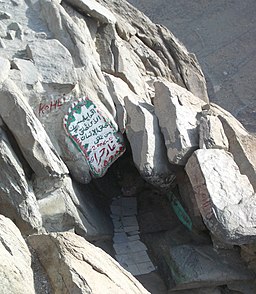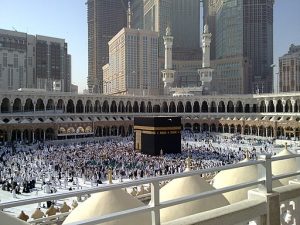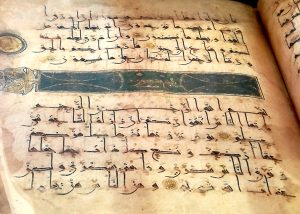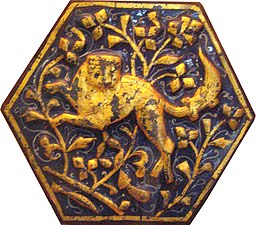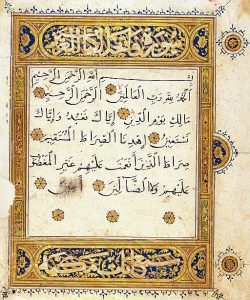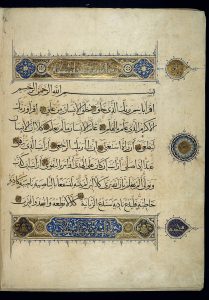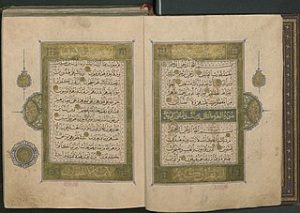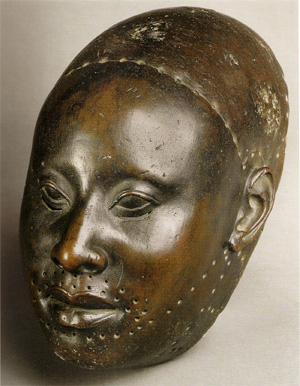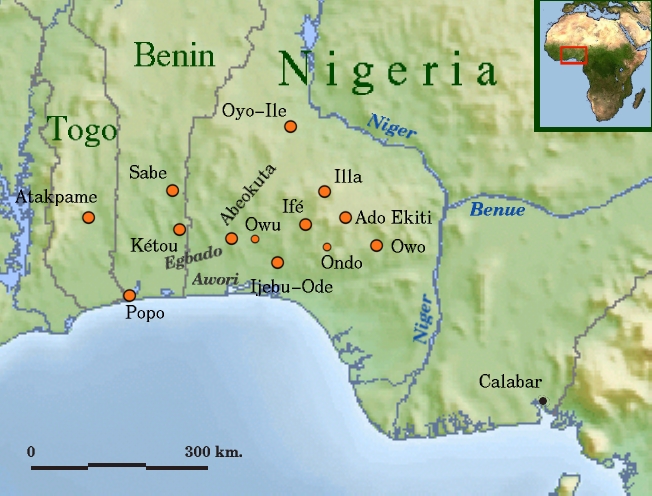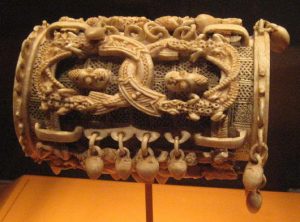Sacred Text
Sacred Text: The Vedas
The Vedas are a collection of hymns and other religious texts composed in India between about 1500 and 1000 BCE. It includes elements such as liturgical material, as well as mythological accounts, poems, prayers, and formulas considered to be sacred by the Vedic religion. (7)
The origin of the Vedas can be traced back as far as 1500 BCE, when a large group of nomads called the Aryans, coming from central Asia, crossed the Hindu Kush Mountains, migrating into the Indian subcontinent. We do not know much about the authors of these texts: In Vedic tradition the focus tends to be on the ideas rather than on the authors , which may allow one to look at the message without being influenced by the messenger.
Vedic literature is religious in nature and as such tends to reflect the worldview, spiritual preoccupations, and social attitudes of the Brahmans or priestly class of ancient India. The Vedas were first composed sometime around 1500—1000 BCE in the north-western region of the Indian subcontinent– present day Pakistan and northwest India — and they were transmitted orally over many generations before eventually being committed to writing. Like the Homeric epics, parts of the Vedas were composed in different periods. The oldest of these texts is the Rig–Veda, but it is not possible to establish precise dates for its composition. It is believed that the entire collection was completed by the end of the second millennium BCE.
In general, the Vedas have a strong priestly bias, as the priestly class had the monopoly in the edition and transmission of these texts.
The Rig-Veda is the largest and most important text of the Vedic collection; it includes 1028 hymns and it is divided into ten books called mandalas . It is a difficult text, written in a very obscure style and filled with metaphors and allusions that are hard to understand for the modern reader. The Sama-Veda has verses that are almost entirely from the Rig-Veda, but are arranged in a different way since they are to be chanted. The Yajur-Veda is divided into the White and Black Yajur-Veda and contains explanatory commentaries on how to perform religious rituals and sacrifices. The Atharva-Veda contains charms and magical incantations and has a more folkloristic style.
The Vedas present a multitude of gods, most of them related to natural forces such as storms, fire, and wind. As part of its mythology, Vedic texts contain multiple creation stories, most of them inconsistent with each other. Sometimes the Vedas refer to a particular god as the greatest god of all, and later another god will be regarded as the greatest god of all.
Some elements of the religion practiced by the natives of India before Vedic times still persist in the Vedas. The Pre-Vedic religion, the oldest known religion of India, which was found in India before the Aryan migrations, was apparently an animistic and totemic worship of many spirits dwelling in stones, animals, trees, rivers, mountains, and stars. Some of these spirits were good, others were evil, and great magic skill was the only way to control them. Traces of this old religion are still present in the Vedas. In the Atharva-Veda, for example, there are spells to obtain children, to avoid abortion, to prolong life, to ward off evil, to woo sleep, and to harm or destroy enemies. (7)
Sacred Text: The Upanishads
The Upanishads are a collection of texts of religious and philosophical nature, written in India probably between c. 800 BCE and c. 500 BCE, during a time when Indian society started to question the traditional Vedic religious order. Some people during this time decided to engage in the pursuit of spiritual progress, living as ascetic hermits, rejecting ordinary material concerns, and giving up family life. Some of their speculations and philosophy were compiled into the Upanishads. There is an attempt in these texts to shift the focus of religious life from external rites and sacrifices to internal spiritual quests in the search for answers.
Etymologically, the name Upanishad is composed of the terms upa (near) and shad (to sit), meaning something like “sitting down near .” The name is inspired by the action of sitting at the feet of an illuminated teacher to engage in a session of spiritual instructions, as aspirants still do in India today.
The books, then, contain the thoughts and insights of important spiritual Indian figures. Although we speak of them together as a body of texts, the Upanishads are not parts of a whole, like chapters in a book. Each is complete in itself. Therefore, they represent not a consistent philosophy or worldview, but rather the experiences, opinions, and lessons of many different men and women. (4)
Sacred Text: Bhagavad Gita
The Bhagavad Gita is an ancient Indian text that became an important work of Hindu tradition in terms of both literature and philosophy. The earliest translations of this work from Sanskrit into English occurred around 1795 CE by Sir Charles Wilkins. The name Bhagavad Gita means “ the song of the Lord ”. It is composed as a poem and it contains many key topics related to the Indian intellectual and spiritual tradition. Although it is normally edited as an independent text, the Bhagavad Gita became a section of a massive Indian epic named “The Mahabharata,” the longest Indian epic. There is a part in the middle of this long text, consisting of 18 brief chapters and about 700 verses: this is the section known as the Bhagavad Gita. It is also referred to as the Gita , for short.
Around the time when the Gita was written, asceticism was seen in India as the ideal spiritual life. Ascetics from different sects along with Jains and Buddhists all agreed that leaving everything behind (family, possessions, occupations, etc.) was the best way to live in a meaningful way.
The Bhagavad Gita revolves around the following questions:
How can someone live a life spiritually meaningful without withdrawing from society?
What can someone who does not want to give up family and social obligations do to live the right way?
The Gita challenges the general consensus that only ascetics and monks can live a perfect spiritual life through renunciation and emphasizes the value of an active spiritual life.
The Plot of the Gita
The plot of the Gita is based on two sets of cousins competing for the throne: The Pandavas and the Kauravas .
Diplomacy has failed, so these two clans’ armies meet on a battlefield in order to settle the conflict and decide which side will gain the throne. This is a major battle and it takes place in Kurukshetra, “the field of the Kurus,” in the modern state of Haryana in India.
Arjuna , the great archer and leader of the Pandavas, is a member of the Kshatriyas caste (the warrior rulers caste). He looks out towards his opponents and recognizes friends, relatives, former teachers, and finally realizes that controlling the kingdom is not worth the blood of all his loved ones. Emotionally overwhelmed, Arjuna drops down, casts aside his bow and arrows, and decides to quit. He prefers to withdraw from battle; he prefers inaction instead of being responsible for the death of the people he loves.
His chariot driver is the god Vishnu, who has taken the form of Krishna. Krishna sees Arjuna quitting and begins to persuade Arjuna that he should stick to his duty as a warrior and engage the enemy.
The Bhagavad Gita is presented as a conversation between Arjuna and Krishna, a man and a god, a seeker and a knower.(8)
Key Takeaways
- Integral to Hindu Theology is: Samsara is the concept of reincarnation, Karma, Dharma, Moksha, Brahman, and the Yogas.
- Vedic literatures religious in nature and as such tends to reflect the worldview, spiritual preoccupations, and social attitudes of the Brahmans or priestly class of ancient India.
- The Upanishads are a collection of texts of religious and philosophical nature. They tell us that the core of our own self is not the body, or the mind, but atmanor “ Self”.
- The Bhagavad Gita is an ancient Indian text that became an important work of Hindu tradition in terms of both literature and philosophy
Early Years and History of Buddhism
Introduction
Buddhism is a religion indigenous to the Indian subcontinent that encompasses a variety of traditions, beliefs and practices largely based on teachings attributed to Siddhartha Gautama, who is commonly known as the Buddha (meaning “the awakened one” in Sanskrit and Pāli). The Buddha lived and taught in the eastern part of the Indian subcontinent between the 6th and 4th centuries BCE. He is recognized by Buddhists as an awakened or enlightened teacher who shared his insights to help sentient beings end suffering (dukkha) through eliminating ignorance (avidyā) by way of understanding and seeing dependent origination (pratītyasamutpāda) and eliminating craving (taṇhā), and thus attain the highest happiness, nirvāņa.
Two major branches of Buddhism are generally recognized:
Theravada (“The School of the Elders”)
Theravada has a widespread following in Sri Lanka and Southeast Asia (Cambodia, Laos, Thailand, Myanmar etc.).
Mahayana (“The Great Vehicle”)
Mahayana is found throughout East Asia (China, Korea, Japan, Vietnam, Singapore, Taiwan etc.) and includes the traditions of Pure Land, Zen, Nichiren Buddhism, Tibetan Buddhism, Shingon, and Tiantai (Tendai).
In some classifications, Vajrayana —practiced mainly in Tibet and Mongolia, and adjacent parts of China and Russia—is recognized as a third branch, while others classify it as a part of Mahayana.
While Buddhism remains most popular within Asia, both branches are now found throughout the world. Estimates of Buddhists worldwide vary significantly depending on the way Buddhist adherence is defined. Conservative estimates are between 350 and 750 million. Higher estimates are between 1.2 and 1.7 billion. It is also recognized as one of the fastest growing religions in the world. (19)
The Three Jewels
Buddhist schools vary on the exact nature of the path to liberation, the importance and canonicity of various teachings and scriptures, and especially their respective practices. The foundations of Buddhist tradition and practice are the Three Jewels :
- The Buddha
- The Dharma (the teachings)
- The Sangha (the community)
Taking “refuge in the triple gem” has traditionally been a declaration and commitment to being on the Buddhist path, and in general distinguishes a Buddhist from a non-Buddhist.
Other practices may include following ethical precepts; support of the monastic community; renouncing conventional living and becoming a monastic; the development of mindfulness and practice of meditation; cultivation of higher wisdom and discernment; study of scriptures; devotional practices; ceremonies; and in the Mahayana tradition, invocation of buddhas and bodhisattvas. (19)
Early Years of the Buddha and the Four Sights
There is no agreement on when Siddhartha was born. This is still a question mark both in scholarship and Buddhist tradition. Several dates have been proposed, but the many contradictions and inaccuracies in the different chronologies and dating systems make it impossible to come up with a satisfactory answer free of controversy.
Modern scholarship agrees that the Buddha passed away at some point between 410 and 370 BCE, about 140-100 years before the time of Indian Emperor Ashoka’s reign (268-232 BCE). Both scholars and Buddhist tradition agree that the Buddha lived for 80 years. More exactness on this matter seems impossible.
Siddhartha’s caste was the Kshatriya caste (the warrior rulers caste). He belonged to the Sahkya clan and was born in the Gautama family. Because of this, he became to be known as Shakyamuni “sage of the Shakya clan”, which is the most common name used in the Mahayana literature to refer to the Buddha. His father was named Śuddhodana and his mother, Maya. (20)
According to this narrative, shortly after the birth of young prince Gautama, an astrologer visited the young prince’s father and prophesied that Siddhartha would either become a great king or renounce the material world to become a holy man, depending on whether he saw what life was like outside the palace walls.
Śuddhodana was determined to see his son become a king, so he prevented him from leaving the palace grounds. But at age 29, despite his father’s efforts, Gautama ventured beyond the palace several times. In a series of encounters—known in Buddhist literature as the four sights—he learned of:
- The suffering of ordinary people, encountering an old man
- A sick man
- A corpse
- An ascetic holy man, apparently content and at peace with the world
These experiences prompted Gautama to abandon royal life and take up a spiritual quest. (19)
Historical Context
After leaving Kapilavastu, Siddhartha practiced the yoga discipline under the direction of two of the leading masters of that time: Arada Kalama and Udraka Ramaputra. Siddhartha did not get the results he expected, so he left the masters, engaged in extreme asceticism, and five followers joined him. For a period of six years Siddhartha tried to attain his goal but was unsuccessful. After realizing that asceticism was not the way to attain the results he was looking for, he gave up this way of life. (21)
After eating a meal and taking a bath, Siddhartha sat down under a tree of the species ficus religiosa, where he finally attained Nirvana (perfect enlightenment) and became known as the Buddha.
Soon after this, the Buddha delivered his first sermon in a place named Sarnath, also known as the “deer park,” near the city of Varanasi. This was a key moment in the Buddhist tradition, traditionally known as the moment when the Buddha “set in motion the wheel of the law. ” The Buddha explained the middle way between asceticism and a life of luxury, the four noble truths (suffering, its origin, how to end it, and the eightfold path or the path leading to the extinction of suffering), and the impersonality of all beings.
The Buddha’s first disciples joined him around this time, and the Buddhist monastic community, known as Sangha, was established. Sariputra and Mahamaudgalyayana were the two chief disciples of the Buddha. Mahakasyapa was also an important disciple who became the convener of the First Buddhist Council. From Kapilavastu and Sravasti in the north, to Varanasi, Nalanda and many other areas in the Ganges basin, the Buddha preached his vision for about 45 years. During his career he visited his hometown, met his father, his foster mother and even his son, who joined the Sangha along with other members of the Shakya clan. Upali, another disciple of the Buddha, joined the Sangha around this time: he was a Shakya and regarded as the most competent monk in matters of monastic discipline. Ananda, a cousin of the Buddha, also became a monk; he accompanied the Buddha during the last stage of his life and persuaded him to admit women into the Sangha, thus establishing the Bhikkhuni Sangha, the female Buddhist monastic community.
During his career, some kings and other rulers are described as followers of the Buddha. The Buddha’s adversary is reported to be Davadatta, his own cousin, who became a follower of the Buddha and turned out to be responsible for a schism of the Sangha, and he even tried to kill the Buddha.
The last days of the Buddha are described in detail in an ancient text named Mahaparinirvana Sutra. We are told that the Buddha visited Vaishali, where he fell ill and nearly died. Some accounts say that here the Buddha delivered his last sermon. After recovering, the Buddha travelled to Kushinagar. On his way, he accepted a meal from a smith named Cunda, which made him sick and led to his death. Once he reached Kushinagar, he encouraged his disciples to continue their activity one last time and he finally passed away. (21)
Forming of Two Separate Buddhist Lines
About a century after the death of Buddha, during the Second Buddhist Council, we find the first major schism ever recorded in Buddhism: The Mahasanghika School.
Many different schools of Buddhism had developed at that time. Buddhist tradition speaks about 18 schools of early Buddhism, although we know that there were more than that, probably around 25.
A Buddhist school named Sthaviravada (in Sanskrit “ school of the elders ”) was the most powerful of the early schools of Buddhism. Traditionally, it is held that the Mahasanghika School came into existence as a result of a dispute over monastic practice. They also seem to have emphasized the supramundane nature of the Buddha, so they were accused of preaching that the Buddha had the attributes of a god. As a result of the conflict over monastic discipline, coupled with their controversial views on the nature of the Buddha, the Mahasanghikas were expelled, thus forming two separate Buddhist lines: the Sthaviravada and the Mahasanghika .
During the course of several centuries, both the Sthaviravada and the Mahasanghika schools underwent many transformations, originating different schools.
- The Theravada School, which still exists in our day, emerged from the Sthaviravada line, and is the dominant form of Buddhism in Myanmar, Cambodia, Laos, Sri Lanka, and Thailand.
- The Mahasanghika School eventually disappeared as an ordination tradition.
- During the 1st century CE, while the oldest Buddhist groups were growing in south and south-east Asia, a new Buddhist school named Mahayana (“ Great Vehicle ”) originated in northern India. This school had a more adaptable approach and was open to doctrinal innovations.
- Mahayama Buddhism is today the dominant form of Buddhism in Nepal, Tibet, China, Japan, Mongolia, Korea, and Vietnam. (20)
Buddhism Today
Buddhism Today
In the 21st century CE, it is estimated that 488 million (9-10% of the world population) people practice Buddhism. Approximately half are practitioners of Mahayana schools in China and it continues to flourish. The main countries that practice Buddhism currently are China, Japan, Korea, and Vietnam. Due to the Chinese occupation of Tibet, Tibetan Buddhism has been adopted by international practitioners, notably westerners, in a variety of different countries.
In the 21st century CE, it is estimated that 488 million (9-10% of the world population) people practice Buddhism. Approximately half are practitioners of Mahayana schools in China and it continues to flourish. The main countries that practice Buddhism currently are China, Japan, Korea, and Vietnam. Due to the Chinese occupation of Tibet, Tibetan Buddhism has been adopted by international practitioners, notably westerners, in a variety of different countries.
‘Socially Engaged Buddhism,’ which originated in 1963 in war-ravaged Vietnam, a term coined by Tchich Nhat Hanh, the international peace activist, is a contemporary movement concerned with developing Buddhist solutions to social, political and ecological global problems. This movement is not divided between monastic and lay members and includes Buddhists from Buddhist countries, as well as western converts. Cambodia, Thailand, Myanmar, Bhutan, and Sri Lanka are the major Buddhist countries (over 70% of population practicing) while Japan, Laos, Taiwan, Singapore, South Korea, and Vietnam have smaller but strong minority status.
New movements continue to develop to accommodate the modern world. Perhaps the most notable are the Dalit Buddhist Movement (Dalits are a group of Indians known as the ‘untouchables’ because they fall outside the rigid caste system but who are now gaining respect and status supported by UN); New Kadampa Tradition, led by Tibetan monk Gyatso Kelsang, which claims to be Modern Buddhism focused on lay practitioners; and the Vipassana Movement, consisting of a number of branches of modern Theravada Buddhism which have moved outside the monasteries, focusing on insight meditation.(22)
Buddhist Theology
The Buddha was not concerned with satisfying human curiosity related to metaphysical speculations. The Buddha ignored topics, such as the existence of god, the afterlife, and creation stories. During the centuries, Buddhism has evolved into different branches, and many of them have incorporated a number of diverse metaphysical systems, deities, astrology and other elements that the Buddha did not consider. In spite of this diversity, Buddhism has a relative unity and stability in its moral code. (20)
The Four Noble Truths
The Four Truths, also commonly known as ‘The Four Noble Truths’ explain the basic orientation of Buddhism. They are the truths understood by the ‘worthy ones,’ those who have attained enlightenment or nirvana.
The four truths are dukkha (the truth of suffering); the arising of dukkha (the causes of suffering); the stopping of dukkha (the end of suffering), and the path leading to the stopping of dukkha (the path to freedom from suffering). (23)
Analogy of Understanding the Four Noble Truths
The Four Truths are often best understood using a medical framework:
- Truth 1 is the diagnosis of an illness or condition
- Truth 2 is identifying the underlying causes of it
- Truth 3 is its prognosis or outcome
- Truth 4 is its treatment
Truth 1: The Truth of Suffering
All humans experience surprises, frustrations, betrayals, etc., which lead to unhappiness and suffering. Acknowledging or accepting that we will encounter difficulties in daily life as an inevitable and universal part of life as a human being is the first truth. Within this, there are two types of suffering :
- Natural suffering: Disasters, wars, infections, etc.
- Self-inflicted suffering: Habitual reacting and unnecessary anxiety and regret
Truth 2: The Causes of Suffering
All suffering lies not in external events or circumstances but in the way we react to and deal with them, our perceptions and interpretations. Suffering emerges from craving for life to be other than it is, which derives from the 3 poisons :
- Ignorance (Delusion) of the fact that everything, including the self, is impermanent and interdependent.
- Desire (Greed) of objects and people who will help us to avoid suffering.
- Aversion (Anger) to the things we do not want, thinking we can avoid suffering. We can learn to look at each experience as it happens and be prepared for the next. (23)
Truth 3: The End of Suffering
We hold limiting ideas about ourselves, others, and the world, of which we need to let go. We can unlearn everything from our social conditioning and so bring down all barriers or separations. (23)
Truth 4: The Path that Frees us from Suffering
The mind leads us to live in a dualistic way, but if we are aware of and embrace our habits and illusions, we can abandon our expectations about the ways things should be and instead accept the way they are. We can use mindfulness and meditation to examine our views and gain an accurate perspective.
This Truth contains the Eightfold Path leading out of samsara to nirvana. It consists of:
- Right View: Accepting the fundamental Buddhist teachings
- Right Resolve: Adopting a positive outlook and a mind free from lust, ill-will, and cruelty
- Right Speech: Using positive and productive speech as opposed to lying, frivolous or harsh speech
- Right Action: Keeping the five precepts — refraining from killing, stealing, misconduct, false speech, and taking intoxicants
- Right Livelihood: Avoiding professions which harm others such as slavery of prostitution
- Right Effort: Directing the mind towards wholesome goals
- Right Mindfulness: Being aware of what one is thinking, doing, and feeling at all times
- Right Meditation: Focusing attention in order to enter meditational states
These eight aspects of the path are often divided into 3 groups: Insight (Right View, Right Resolve), morality (Right Speech, Right Action, Right Livelihood), and meditation (Right Effort, Right Mindfulness, Right Meditation).
This eightfold path is not linear, passing from one stage to the next, but cumulative so that ideally all eight factors are practiced simultaneously. (23)

Figure 3-2 : Dharma Wheel by Ibolya Horvath is licensed under CC-BY 3.0 . The Dharmachakra (Wheel of the law with eight spokes) represents the Eightfold Path.
Karma and Samsara
In Buddhism, essentially there is no soul. The unresolved karmas manifest into a new form composed of five skandhas (constituent elements of a being) in one of the six realms of samsara. The eventual nirvana (salvation) comes through the annihilation of residual karma, which means the ceasing of the alleged existence of being. The actions with intention (cetana) carried out by the mind, body, and speech and which are driven by ignorance, desire, and hatred lead to implications that tie one down in samsara. Following the eightfold path — the set of eight righteous ways of thinking and acting suggested by Buddha — one can attain nirvana.
Dukkha (Suffering)
Dukkha is defined in more detail as the human tendency to cling to or crave impermanent states or objects, which keep us caught in samsara, the endless cycle of repeated birth, suffering and dying. It is thought that the Buddha taught the Four Truths in the very first teaching after he had attained enlightenment as recorded long after his physical death in the Dhammacakkappavattana Sutra (‘The Discourse that Sets Turning the Wheel of Truth’), but this is still in dispute. They were recognized as perhaps the most important teachings of the Buddha Shakyamuni only at the time the commentaries were written, c. 5th century CE. (23)
Key Takeaways
- Buddhism is largely based on the teachings of Siddhartha Gautama (Buddha). He is recognized by Buddhists as an awakened or enlightened teacher who shared his insights to help sentient beings end suffering through eliminating ignorance, by way of understanding and seeing dependent origination, and eliminating craving, and thus attain the highest happiness, nirvāņa.
- The Four Truths, also commonly known as ‘The Four Noble Truths’ explain the basic orientation of Buddhism. They are the truths understood by the ‘worthy ones,’ those who have attained enlightenment or nirvana
Religious Practice During the Shang and Zhou Dynasties
Introduction to Chinese Religions
Religious practices in ancient China go back over 7,000 years. Long before the philosophical and spiritual teachings of Confucius and Lao-Tzu developed or before the teachings of the Buddha came to China, the people worshipped personifications of nature and then of concepts like “wealth” or “fortune” which developed into a religion. These beliefs still influence religious practices today. For example, the Tao te Ching of Taoism maintains that there is a universal force known as the Tao which flows through all things and binds all things but makes no mention of specific gods to be worshipped; still, modern Taoists in China (and elsewhere) worship many gods at private altars and in public ceremonies which originated in the country’s ancient past. (24)
An Overview of Chinese Religious History
Chinese Prehistoric Religious Practice
In China, religious beliefs are evident in the Yangshao Culture of the Yellow River Valley, which prospered between 5000-3000 BCE. At the Neolithic site of Banpo Village in modern Shaanxi Province (dated to between c. 4500–3750 BCE) 250 tombs were found containing grave goods, which point to a belief in life after death. There is also a ritualistic pattern to how the dead were buried with tombs oriented west to east to symbolize death and rebirth. Grave goods provide evidence of specific people in the village who acted as priests and presided over some kind of divination and religious observance.
The Yangshao Culture was matrilineal, meaning women were dominant, so this religious figure would have been a woman based on the grave goods found. There is no evidence of any high-ranking males in the burials, but a significant number of females. Scholars believe that the early religious practices were also matrilineal and most likely animistic, where people worship personifications of nature, and usually feminine deities were benevolent and male deities malevolent, or at least more to be feared.
These practices continued with the Qijia Culture (c. 2200–1600 BCE) who inhabited the Upper Yellow River Valley but whose culture could have been patriarchal. Examinations of the Bronze Age site of Lajia Village in modern-day Qinghai Province (and elsewhere) have uncovered evidence of religious practices. Lajia Village is often referred to as the “Chinese Pompeii” because it was destroyed by an earthquake, which caused a flood and the resulting mudslides buried the village intact. Among the artifacts uncovered was a bowl of noodles which scientists have examined and believe to be the oldest noodles in the world and precursors to China’s staple dish “Long-Life Noodles.” Even though not all scholars or archaeologists agree on China as the creator of the noodle, the finds at Lajia support the claim of religious practices there as early as c. 2200 BCE. There is evidence that the people worshipped a supreme god who was king of many other lesser deities. (24)
Religious Practice During the Shang Dynasty
By the time of the Shang Dynasty (1600–1046 BCE) these religious beliefs had developed so that now there was a definite “k ing of the gods ” named Shangti and many lesser gods of other names. Shangti presided over all the important matters of state and was a very busy god. He was rarely sacrificed to because people were encouraged not to bother him with their problems. Ancestor worship may have begun at this time but more likely, started much earlier.
Evidence of a strong belief in ghosts , in the form of amulets and charms , goes back to at least the Shang Dynasty and ghost stories are among the earliest form of Chinese literature. Ghosts (known as guei or kuei) were the spirits of deceased persons who had not been buried correctly with due honors or were still attached to the earth for other reasons. They were called by a number of names but in one form, jiangshi (“stiff body”), they appear as zombies . Ghosts played a very important role in Chinese religion and culture and still do. The ritual still practiced in China today known as Tomb Sweeping Day (usually around 4 April) is observed to honor the dead and make sure they are happy in the afterlife. If they are not, they are thought to return to haunt the living. The Chinese visit the graves of their ancestors on Tomb Sweeping Day during the Festival of Qingming, even if they never do at any other time of the year, to tend the graves and pay their respects.
When someone died naturally or was buried with the proper honors, there was no fear of them returning as a ghost. The Chinese believed that, if the person had lived a good life, they went to live with the gods after death. These spirits of one’s ancestors were prayed to so they could approach Shangti with the problems and praise of those on earth. Tanner (2010) writes:
Ancestors were represented by a physical symbol such as a spirit tablet engraved or painted with the ancestor’s honorific name. Rituals were held to honor these ancestors, and sacrifices of millet ale, cattle, dogs, sheep, and humans were offered. The scale of the sacrifices varied, but at important rituals, hundreds of animals and/or human sacrifices would be slaughtered. Believing that the spirits of the dead continued to exist and to take an interest in the world of the living, the Shang elite buried their dead in elaborate and well-furnished tombs.
The spirits of these ancestors could help a person in life by revealing the future to them. Divination became a significant part of Chinese religious beliefs and was performed by people with mystical powers (what one would call a “psychic” in the modern day) one would pay to tell one’s future through oracle bones. It is through these oracle bones that writing developed in China. The mystic would write the question on the shoulder bone of an ox or turtle shell and apply heat until it cracked; whichever way the crack went would determine the answer. It was not the mystic or the bone that gave the answer but one’s ancestors who the mystic communed with. These ancestors were in touch with eternal spirits, the gods, who controlled and maintained the universe. (24)
Religious Practice During the Zhou Dynasty

In the Zhou Dynasty (c. 1046–226 BCE) the concept of the Mandate of Heaven was developed. The Mandate of Heaven was the belief that Shangti ordained a certain emperor or dynasty to rule and allowed them to rule as long as they pleased him. When the rulers were no longer taking care of the people responsibly, they were said to have lost the Mandate of Heaven and were replaced by another. Modern scholars have seen this simply as a justification for changing a regime, but the people at the time believed in the concept. The gods were thought to watch over the people and would pay special attention to the emperor. People continued a practice, which began toward the end of the Shang Dynasty, of wearing charms and amulets of their god of choice or their ancestors for protection or in the hope of blessings, and the emperor did this as well. Religious practices changed during the latter part of the Zhou Dynasty owing to its decline and eventual fall, but the practice of wearing religious jewelry continued.
The Zhou Dynasty is divided into two periods: Western Zhou (1046–771 BCE) and Eastern Zhou (771–226 BCE). Chinese culture and religious practices flourished during the Western Zhou period but began to break apart during the Eastern Zhou. Religious practices of divination, ancestor worship, and veneration for the gods continued, but during the Spring and Autumn Period (772–476 BCE) philosophical ideas began to challenge the ancient beliefs.
Confucius (c. 551–479 BCE) encouraged ancestor worship as a way of remembering and honoring one’s past but emphasized people’s individual responsibility in making choices and criticized an over-reliance on supernatural powers. Mencius (c. 372–289 BCE) developed the ideas of Confucius, and his work resulted in a more rational and restrained view of the world.
The work of Lao-Tzu (c. 500 BCE) and the development of Taoism might be seen as a reaction to Confucian principles if not for the fact that Taoism developed many centuries before the traditional date assigned to Lao-Tzu.
It is much more probable that Taoism developed from the original nature/folk religion of the people of China than that it was created by a 6th-century BCE philosopher. Therefore, it is more accurate to say that the rationalism of Confucianism probably developed as a reaction to the emotionalism and spiritualism of those earlier beliefs. (24)
Warring States Period
Religious beliefs developed further during the next period in China’s history, The Warring States Period (476–221 BCE), which was very chaotic. The seven states of China were all independent now that the Zhou had lost the Mandate of Heaven, and each one fought the others for control of the country. Confucianism was the most popular belief during this time, but there was another, which was growing stronger.
A statesman named Shang Yang (died 338 BCE) from the region of Qin developed a philosophy called Legalism , which maintained that people were only motivated by self-interest, were inherently evil, and had to be controlled by law. Shang Yang’s philosophy helped the State of Qin overpower the six other states and from that the Qin Dynasty was founded by the first emperor, Shi Huangti, in 221 BCE. (24)
Key Takeaways
- Shang Dynasty (1600–1046 BCE) religious beliefs had developed so that now there was a definite “king of the gods ” named Shangti. Evidence of a strong belief in ghosts, in the form of amulets and charms, goes back to at least the Shang Dynasty and ghost stories are among the earliest form of Chinese literature
- In the Zhou Dynasty (c. 1046–226 BCE) the concept of the Mandate of Heaven was developed. The Mandate of Heaven was the belief that Shangti ordained a certain emperor or dynasty to rule and allowed them to rule as long as they pleased him.
Religious Practice During the Qin and Han Empires
Qin Dynasty
During the Qin Dynasty (221–206 BCE), Shi Huangti banned religion and burned philosophical and religious works. Legalism became the official philosophy of the Qin government and the people were subject to harsh penalties for breaking even minor laws. Shi Huangti outlawed any books, which did not deal with his family line, his dynasty, or Legalism, even though he was personally obsessed with immortality and the afterlife, and his private library was full of books on these subjects. Confucian scholars hid books as best as they could and people would worship their gods in secret but were no longer allowed to carry amulets or wear religious charms.
Han Dynasty
Shi Huangti died in 210 BCE while searching for immortality on a tour through his kingdom. The Qin Dynasty fell soon after, in 206 BCE, and the Han Dynasty took its place. The Han Dynasty (202 BCE–220 CE) at first continued the policy of Legalism but abandoned it under Emperor Wu (141–87 BCE). Confucianism became the state religion and grew more and more popular even though other religions, like Taoism, were also practiced.
During the Han Dynasty, the emperor became distinctly identified as the mediator between the gods and the people. The position of the emperor had been seen as linked to the gods through the Mandate of Heaven from the early Zhou Dynasty, but now it was his express responsibility to behave so that heaven would bless the people.
Arrival of Buddhism
In the 1st century CE, Buddhism arrived in China via trade through the Silk Road. According to the legend, the Han emperor Ming (28–75 CE) had a vision of a golden god flying through the air and asked his secretary who that could be. The assistant told him he had heard of a god in India who shone like the sun and flew in the air, and so Ming sent emissaries to bring Buddhist teachings to China. Buddhism quickly combined with the earlier folk religion and incorporated ancestor worship and veneration of Buddha as a god.
Buddhism was welcomed in China and took its place alongside Confucianism, Taoism, and the blended folk religion as a major influence on the spiritual lives of the people. When the Han Dynasty fell, China entered a period known as The Three Kingdoms (220–263 CE), which was similar to the Warring States Period in bloodshed, violence, and disorder. The brutality and uncertainty of the period influenced Buddhism in China which struggled to meet the spiritual needs of the people at the time by developing rituals and practices of transcendence. The Buddhist schools of Ch’an (better known asZen ), Pure Land, and others took on form at this time. (24)
Religious Practice During the Empire and Beyond

The major religious influences on Chinese culture were in place by the time of the Tang Dynasty (618–907 CE) but there were more to come. The second emperor, Taizong (626–649 CE), was a Buddhist who believed in toleration of other faiths and allowed Manichaeism, Christianity, and others to set up communities of faith in China. His successor, Wu Zeitian (690–704 CE), elevated Buddhism and presented herself as a Maitreya (a future Buddha) while her successor, Xuanzong (712–756 CE), rejected Buddhism as divisive and made Taoism the state religion.
Although Xuanzong allowed and encouraged all faiths to practice in the country, by 817 CE Buddhism was condemned as a dividing force, which undermined traditional values. Between 842–845 CE Buddhist nuns and priests were persecuted and murdered and temples were closed. Any religion other than Taoism was prohibited, and persecutions affected communities of Jews, Christians, and any other faith. The emperor Xuanzong II (846–859 CE) ended these persecutions and restored religious tolerance. The dynasties, which followed the Tang up to the present day all had their own experiences with the development of religion and the benefits and drawbacks which come with it, but the basic form of what they dealt with was in place by the end of the Tang Dynasty. (24)
Rise of the Song Dynasty
The chaos and political void caused by the collapse of the Tang Dynasty led to the break-up of China into five dynasties and ten kingdoms, but one warlord would, as had happened so often before, rise to the challenge and collect at least some of the various states back into a resemblance of a unified China.
The Song Dynasty was, thus, founded. Although the Song Dynasty were able to govern over a united China after a significant period of division, their reign was beset by the problems of a new political and intellectual climate which questioned imperial authority and sought to explain where it had gone wrong in the final years of the Tang dynasty. A symptom of this new thinking was the revival of the ideals of Confucianism, Neo-Confucianism as it came to be called, which emphasized the improvement of the self within a more rational metaphysical framework. This new approach to Confucianism, with its metaphysical add-on, now allowed for a reversal of the prominence the Tang had given to Buddhism, seen by many intellectuals as a non-Chinese religion. (55)
Foundation of Chinese Culture
Confucianism, Taoism, Buddhism, and the early folk religion combined to form the basis of Chinese culture. Other religions have added their own influences but these four belief structures had the most impact on the country and the culture. Religious beliefs have always been very important to the Chinese people even though the People’s Republic of China originally outlawed religion when it took power in 1949 CE. The People’s Republic saw religion as unnecessary and divisive, and during the Cultural Revolution temples were destroyed, churches burned, or converted to secular uses. In the 1970’s CE the People’s Republic relaxed its stand on religion and since then has worked to encourage organized religion as “psychologically hygienic” and a stabilizing influence in the lives of its citizens. (24)
Key Takeaways
- During the Qin Dynasty (221–206 BCE), Shi Huangti banned religion and burned philosophical and religious works. Legalism became the official philosophy of the Qin government and the people were subject to harsh penalties for breaking even minor laws.
- The Han Dynasty (202 BCE–220 CE) at first continued the policy of Legalism but abandoned it under Emperor Wu. Confucianism became the state religion and grew more and more popular
- In the 1st century CE, Buddhism arrived in China via trade through the Silk Road. Buddhism was welcomed in China and took its place alongside Confucianism, Taoism, and the blended folk religion as a major influence on the spiritual lives of the people. Confucianism, Taoism, Buddhism, and the early folk religion combined to form the basis of Chinese culture.













